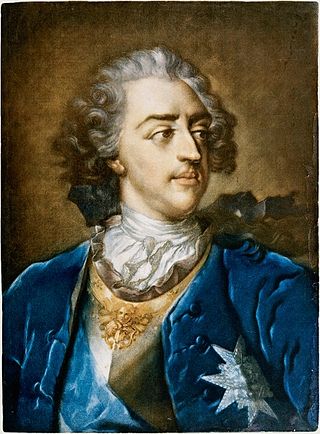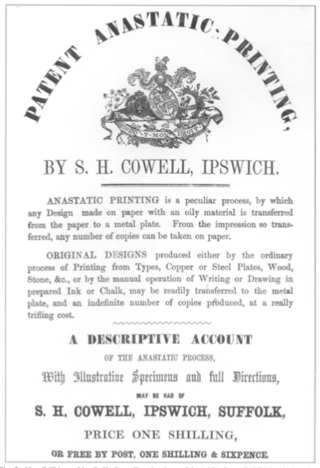
John Phillips FRS was an English geologist. In 1841 he published the first global geologic time scale based on the correlation of fossils in rock strata, thereby helping to standardize terminology including the term Mesozoic, which he invented.

Times and Seasons was a 19th-century Latter Day Saint newspaper published at Nauvoo, Illinois. It was printed monthly or twice-monthly from November 1839 to February 1846. The motto of the paper was "Truth will prevail," which was printed underneath the title heading. It was the successor to the Elders' Journal and was the last newspaper published by the Church in the United States before the schisms that occurred after the death of Joseph Smith.
Color printing or colour printing is the reproduction of an image or text in color.

Tauchnitz was the name of a family of German printers and publishers. They published English language literature for distribution on the European continent outside Great Britain, including initial serial publications of novels by Charles Dickens. Though copyright protection did not exist between nations in the 19th century, Tauchnitz paid the authors for the works they published, and agreed to limit their sales of English-language books to the European continent, as authors like Dickens or Bulwer-Lytton had separate arrangements for publication and sale in Great Britain.

The Institute of the Italian Encyclopaedia Treccani, also known as the Treccani Institute, is a cultural institution of national interest, active in the publishing field, founded by Giovanni Treccani in 1925.

Johann Alois Senefelder was a German actor and playwright who invented the printing technique of lithography in the 1790s.
The Overstreet Comic Book Price Guide is an annually published comic book price guide widely considered the primary authority on the subject of American comic book grading and pricing in the hobby/industry. Numerous observers connect the expansion of the direct market distribution system and the proliferation of comic book specialty shops to the broader recognition and acceptance of Overstreet's annual guide. This guide is considered a standardized inventory and pricing system within the comic book industry.

The Equinox of the Gods is a book first published in 1936 detailing the events and circumstances leading up to Aleister Crowley's 1904 transcription of The Book of the Law, the central text of Thelema.
Photozincography, sometimes referred to as heliozincography but essentially the same process, known commercially as zinco, is the photographic process developed by Sir Henry James FRS (1803–1877) in the mid-nineteenth century.

The Sydney Gazette and New South Wales Advertiser was the first newspaper printed in Australia, running from 5 March 1803 until 20 October 1842. It was a semi-official publication of the government of New South Wales, authorised by Governor Philip King and printed by George Howe. On 14 October 1824, under the editorship of Robert Howe, it ceased to be censored by the colonial government.
The Herald is a six-day morning daily newspaper published in Sharon, Pennsylvania, covering Mercer County and the greater Shenango Valley area of Pennsylvania. It is owned by Community Newspaper Holdings Inc., Montgomery, Ala.
Lieutenant General Sir Henry James was a Royal Engineers officer who served as the director-general of the Ordnance Survey, the British Government mapping agency, from 1854 to 1875. Sir Henry was described by the agency itself as "perhaps Ordnance Survey's most eccentric and egotistical Director General". Sir Henry spent most of his life working for the Ordnance Survey and after becoming its head he introduced the new science of photography. He also would later claim to be the inventor of the process known as Photozincography or Zinco. Sir Henry also played a part in the resolving of the battle of the scales.

A facsimile is a copy or reproduction of an old book, manuscript, map, art print, or other item of historical value that is as true to the original source as possible. It differs from other forms of reproduction by attempting to replicate the source as accurately as possible in scale, color, condition, and other material qualities. For books and manuscripts, this also entails a complete copy of all pages; hence, an incomplete copy is a "partial facsimile". Facsimiles are sometimes used by scholars to research a source that they do not have access to otherwise, and by museums and archives for media preservation and conservation. Many are sold commercially, often accompanied by a volume of commentary.

Jacob Christoph Le Blon, or Jakob Christoffel Le Blon, was a painter and engraver from Frankfurt who invented a halftone color printing system with three and four copper dyes using an RYB color model, which served as the foundation for the modern CMYK system. He used the mezzotint method to engrave three or four copper plates to make prints of paintings and portraits with a wide range of colors.

Edmund Evans was an English wood-engraver and colour printer during the Victorian era. He specialized in full-colour printing, a technique which, in part because of his work, became popular in the mid-19th century. He employed and collaborated with illustrators such as Walter Crane, Randolph Caldecott, Kate Greenaway and Richard Doyle to produce what are now considered to be classic children's books. Little is known about his life, although he wrote a short autobiography before his death in 1905 in which he described his life as a printer in Victorian London.
The text of Domesday Book, the record of the great survey of England completed in 1086 executed for William I of England, was first edited by Abraham Farley in the 1770s. The first facsimile edition of the manuscripts was made in a project led by the cartographer Henry James in the 1860s. An English translation of the Latin text for most counties was published by the Victoria County History (VCH) during much of the 20th century.

Charles Graves was an Irish mathematician, academic, and clergyman. He was Erasmus Smith's Professor of Mathematics at Trinity College Dublin (1843–1862), and was president of the Royal Irish Academy (1861–1866). He served as dean of the Chapel Royal at Dublin Castle, and later as Bishop of Limerick, Ardfert and Aghadoe. He was the brother of both the jurist and mathematician John Graves, and the writer and clergyman Robert Perceval Graves.
The 20 Polish złotych note is a denomination of the Polish złoty.

The Postal Union Congress (PUC) £1 stamp is one of a series of postage stamps of Great Britain issued in 1929. It is one of the classics of British philately and has been described as one of the most beautiful British stamps ever issued. The stamp was only the second British commemorative stamp to be issued. The first were the British Empire Exhibition postage stamps of 1924–25.

Samuel Harrison Cowell was a Suffolk businessman who pioneered anastatic lithography in Ipswich. Cowell issued leaflets at the Great Exhibition in 1851 to advertise the new technology.













